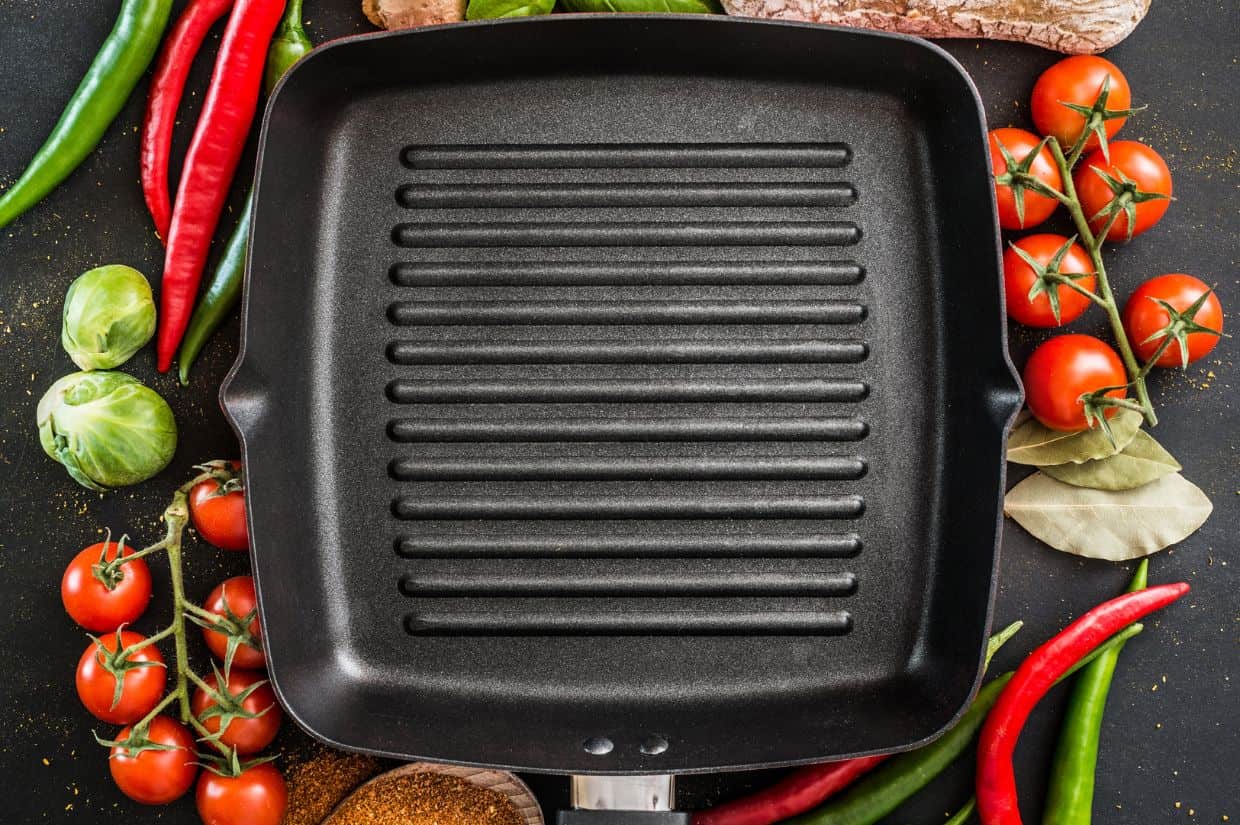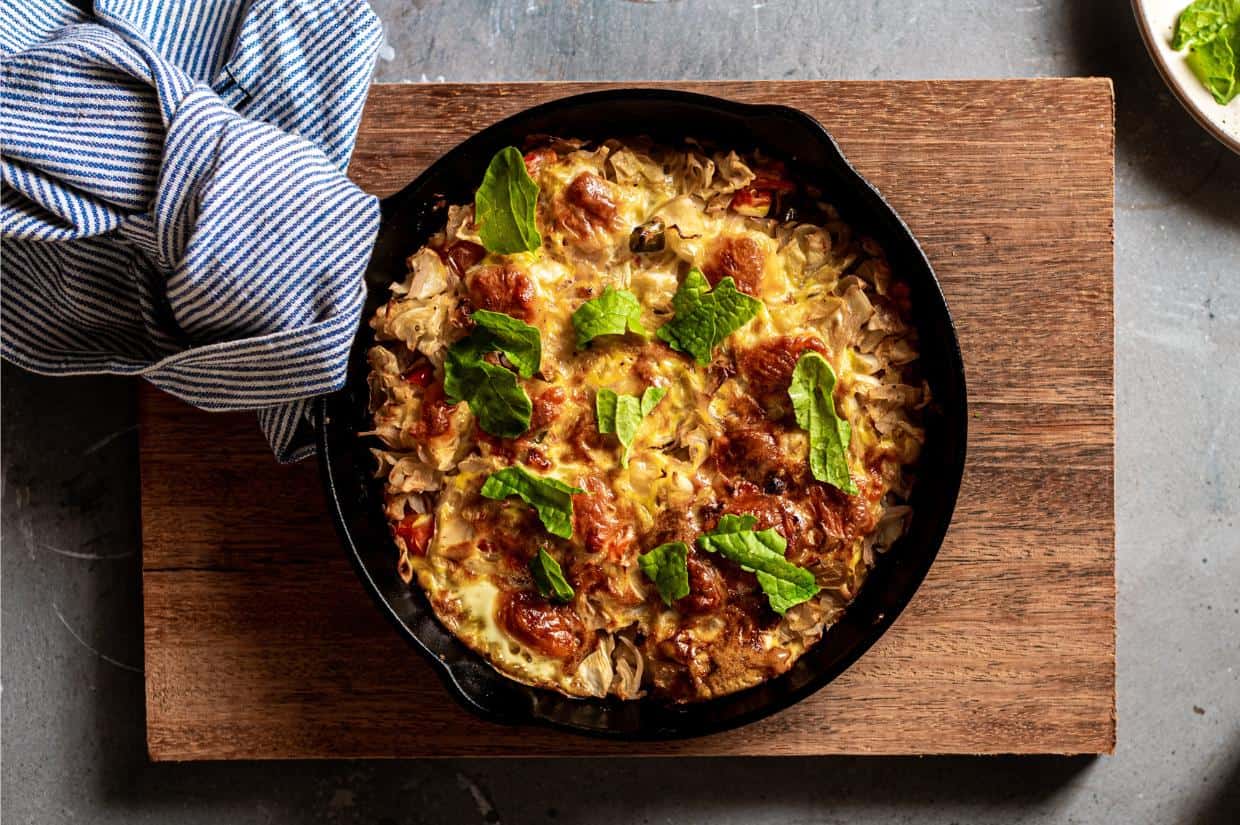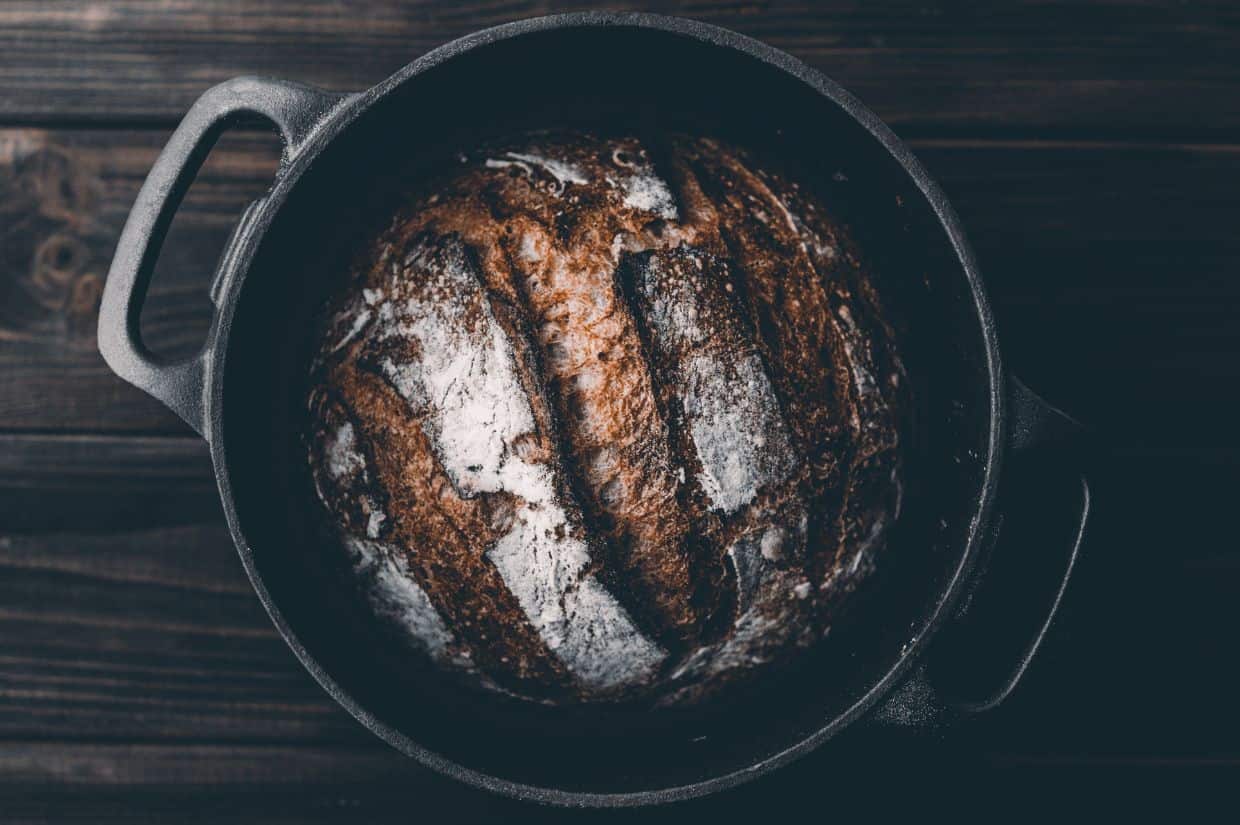Cast iron cookware is renowned among cooks of all skill levels and generations. This timeless cookware is as reliable and durable as it is beautiful. But which piece is right for you?

This post may contain affiliate link(s). As an Amazon Associate, I earn from qualifying purchases. See Disclosures.
Considering cast iron cookware
Whether you’re looking at cast iron for the first time or ready to pick up a new piece for your collection, there are a few things to keep in mind.
What do you like to cook most?
Different recipes call for different tools. If you need an all-in-one for roasting, stewing and deep frying, a Dutch oven is the way to go.
But a skillet is likely best if you’re looking for a daily workhorse for breakfast, lunch and dinner.
Love Saturday morning pancakes? Get a griddle.
What size best suits your needs?
We’ll review the best all-around choices for a typical home chef cooking for two to four people.
The products we choose emphasize versatility and practicality, with a capacity for single recipes and meal prep-friendly batch cooking.
What kind of cooking surface do you need?
Options vary:
- Wide, flat, and open
- Enclosed
- High or short sides
- Ridged or not
- Round, square or rectangular

Best cast iron cookware
Cast iron equipment ranges from pots and pans to tea kettles and casserole dishes, so it can be overwhelming to choose if you’re building a new kitchen. What are the most practical pieces for daily use?
Maybe you already have a foundation and are looking for the next best thing. In that case, what is worth committing your precious storage space to?
We reviewed options from griddles to grill presses, examining their functionality, versatility, care and practicality for home cooks. Our results boiled down to these top five picks every kitchen can benefit from.
Cast iron Dutch oven
Perhaps the most iconic image when it comes to cast iron cookware, a Dutch oven is a heavy-duty cooking pot with high sides. A Dutch oven comes with a tight-fitting lid and has two loop handles on either side for handling.
Its ability to masterfully retain heat and transition between cooking surfaces makes it a star in the kitchen. This pot can be a go-to tool and help simplify your life the more you use it for easy one-pot meals. Plus, placing the Dutch oven on a hot pad at the table is a great way to minimize extra serving dishes, save time cleaning up and bring an aesthetically pleasing feature to the table.
Pros
- Versatile: Use for a range of cooking methods, including braising, simmering, stewing, baking and frying.
- Heat-retention: Dutch ovens retain heat well due to the high walls and tight-fitting lid. This ensures even cooking throughout the food, which produces succulent meat, melded flavors and thick sauces.
- Oven-safe: Allowing for a seamless transition from browning or sautéing on the stovetop to baking in the oven. You can also bake authentically rustic bread in a Dutch oven.
- Kitchen-to-table serving: Finish cooking and bring the Dutch oven directly to the table to serve.
Cons
- Weight: This is the heaviest design because, compared to other options, the pot has the most surface area and volume. Also, the additional lid adds to the overall weight.
- Slow heating and cooling: A Dutch oven takes longer to heat up and cool down than other options and generally isn’t functional for quick meals. However, this exact point makes it ideal for slow cooking and braising.
We recommend the six-quart Dutch oven. Smaller options are better for sauces or side dishes, but six quarts is great for baking artisanal bread, braising roasts and simmering stew. Anything bigger gets pretty heavy to move around, especially once the lid is on and is better suited for large groups of people or very big cuts of meat.
Cast iron skillet
With a smooth cooking surface and long handle, the cast iron skillet distributes heat well across a seasoned, nonstick surface, ready to cook anything from vegetable noodles to skillet cookies.
Unlike the Dutch oven, a skillet has a shallow depth that conducts heat quickly, so you can sear steaks, bake cornbread and scramble eggs.
Pros
- Versatile: Use for searing, sautéing, pan-frying, stir-frying, baking, braising and roasting.
- Heat-retention: The open shape of a skillet allows it to heat up quickly, making it ideal for fast cooking.
- Oven-safe: The cast iron skillet’s oven-safe design facilitates your ability to sauté a base of onion and garlic for a frittata before baking it to perfection.
- Kitchen-to-table serving: Similar to a Dutch oven, a cast iron skillet full of nachos or paella looks mighty fine on the table.
Cons
- Weight: The cast iron skillet can be heavy.
- Limited depth: Skillets do not have tall walls like a Dutch oven or saucepot. Therefore, they are not best for slow cooking, soups or making dishes with large volumes.
- Not for delicate foods: The large surface area is not conducive for delicate foods like sauces, custards or chocolate that require precise temperature control.
We recommend a pre-seasoned 12-inch skillet. A 12-inch diameter tends to be the ideal size for most home kitchens because it gives a cooking surface of around nine to ten inches, suitable for meals serving two to four people.
Cast iron grill pan
Enjoy the flavor and effect of outdoor grilling without investing in a large grill. This is a great solution for people who live in apartments, tiny homes or in cold areas where they cannot cook outside.
Cast iron grill pans are usually square with ridges running across that mimic the grates on a traditional grill.
Pros
- Grilled texture: Get the juicy texture of grilled pork chops without needing an outdoor grill.
- Grill marks: Enhance the visual appeal of food with the classic look of grill marks.
- Versatile: Suitable for meat, vegetables, poultry, fish, seafood and even fruit.
- Low-fat cooking: The raised ridges allow fat to render as it heats and drip down away from the food as it cooks.
Cons
- Cleaning: The grooves make these pans more challenging to clean than flat skillets. However, we use custom grill pan scrapers that fit perfectly and make cleaning much easier.
- Limited smoke flavor: Pan-grilled food might have a similar texture to outdoor grilling, but it doesn’t have the same smoky flavor.
- Limited space: Grill pans are smaller than skillets and griddles, which may result in cooking more batches over longer periods of time.
We recommend a square 10.5-inch grill pan as an ideal choice. These pans will never fail to grill a variety of ingredients to satisfaction and add a signature visual appeal to the food.
Cast iron griddle
Similar to a skillet, cast iron griddles have a flat cooking surface. However, they may be rectangular or circular, typically with a minimal lip around the edge to contain the food.
Pros
- Lightweight: Of all cast iron cookware, griddles are the lightest and easiest to handle without a lot of effort.
- Quick to heat: With the least amount of material out of all the choices we’ve covered thus far, the griddle is the quickest to heat and cool down.
- Versatile: Excellent for pancakes, French toast, eggs, bacon and burgers.
- Spacious: More than a skillet, the griddle offers a very open cooking surface that allows you to cook multiple items simultaneously.
Cons
- Minimal volume: Because there are essentially no walls to this cooking surface, liquids and high-volume recipes are difficult to cook.
- Lack of height: Similarly, tossing ingredients for a stir-fry or stirring without spilling is difficult on a griddle.
Overall, griddles are less versatile than a Dutch oven or skillet. Still, they are excellent at their specialty of providing an open surface to easily flip foods over and cook evenly. Of all cast iron equipment, griddles are the easiest to clean because they have the least amount of angles and crevasses.
We recommend a cast iron griddle to home cooks who frequently cook hot cakes, sandwiches, quesadillas and fried cheese.
Cast iron baking pan
Sometimes called a baking pan, lasagna dish, casserole dish or roasting pan, this item is a rectangular shape with four walls all the way around.
It’s another all-in-one dish you can take from the stove to the oven and then serve at the table. You’ll want one of these for baking meals like Philly cheesesteak casserole throughout the year, cobblers in the summer and Shepherd’s pie in the fall.
Pros
- Balanced weight: The wide rectangle is easy to handle and has two handles on either side that help distribute the weight.
- Heat-retention: Insulates food well, keeping it warm even out of the oven.
- Versatile: Bake bread rolls, cakes and pies or casseroles and roasted vegetables.
- Beautiful: Our favorite choice has a painted enamel coating that takes cast iron to the next level of beauty. Pick your favorite color and add a bright accent to your kitchen.
- Easy to clean
Cons
- Fragile: Be careful not to scratch or chip the enamel coating.
- Bulky: This shape may be harder to store than a griddle, grill pan or skillet.
- Longer preheating time: Preheating yields the best results. This may add to the total cooking time of a recipe.
Cast iron baking dishes retain heat well in a way that promotes uniform baking and moist results. Our team here loves the ability to cook sweet and savory dishes for a crowd. Plus, bringing potluck-ready food from the oven to the feast in such an eye-catching presentation is a huge win.
We recommend a cast iron baking dish to aspiring bakers, those looking for a reliable tool for weeknight dinners and everyone who appreciates the beautiful presentation.

In conclusion
Each cast iron cookware piece brings its own unique value to the kitchen, allowing you to explore a wide range of cooking techniques and flavors. Over time, you can continue to collect and build your cast iron cookware collection until you have them all.
Follow proper cast iron cleaning techniques to preserve the equipment for years to come. Seasoning cast iron correctly is key to preserving it for a lifetime or longer. But don’t worry; it’s easy. Read up on the best tips and prepare before bringing one of these cookware pieces home.
Jessica Haggard is dedicated to helping people cook easy everyday recipes focusing on bioavailable and nutrient-dense foods. She helps people overcome food allergies, discover healthy recipes that make a difference and succeed with gluten-free, low-carb and keto cooking at Primal Edge Health.